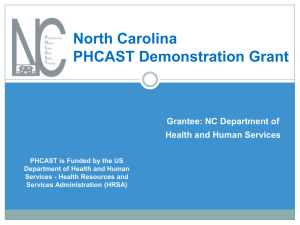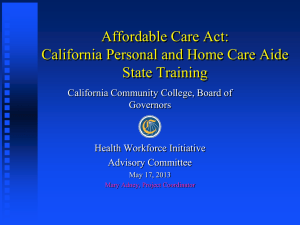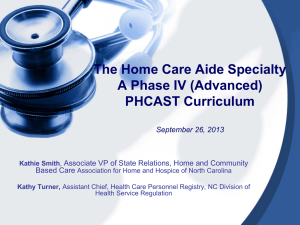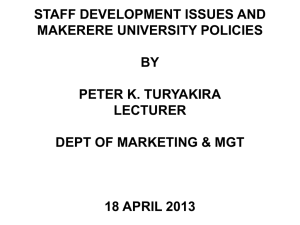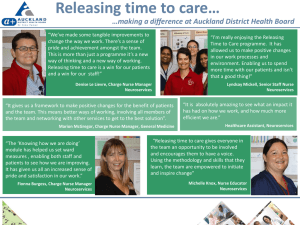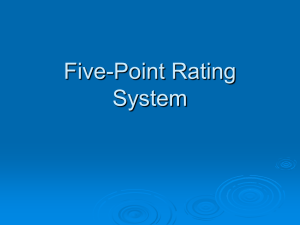Phase I & II Curriculum Overview and Orientation
advertisement
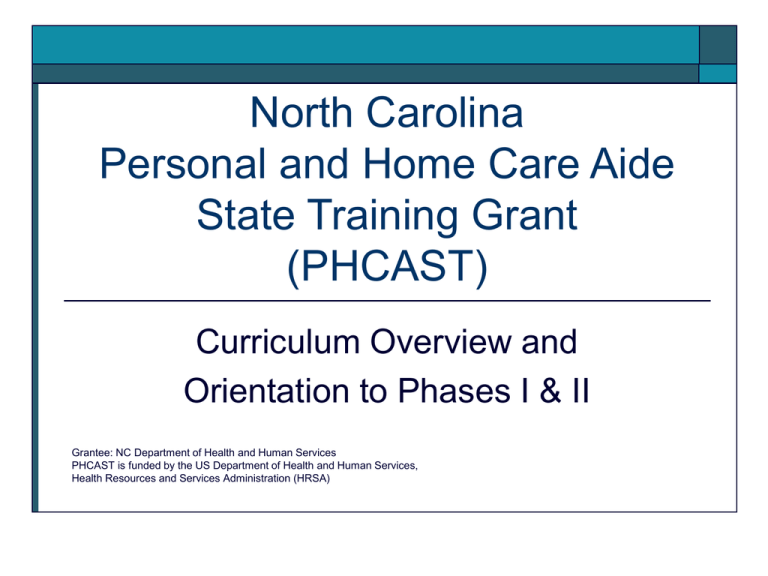
North Carolina Personal and Home Care Aide State Training Grant (PHCAST) Curriculum Overview and Orientation to Phases I & II Grantee: NC Department of Health and Human Services PHCAST is funded by the US Department of Health and Human Services, Health Resources and Services Administration (HRSA) Welcome and Purpose Barbara Boyce PHCAST Management Team Kathy Turner, RN, PHCAST Project Director, Division of Health Service Regulation Jan Moxley, PHCAST Grant Administrator, Division of Aging and Adult Services Donna White, RN, Elder Rights/In-Home Aide, Division of Aging and Adult Services Susan Harmuth, Senior Program Manager, NC Foundation for Advanced Health Programs Phyllis Daw, PHCAST Program Coordinator, NC Foundation for Advanced Health Programs Kathie Smith, RN, Associate Vice President of State Relations, Home & Community-Based Care, Association for Home and Hospice Care of NC Cherie Rosemond, Research Scientist, UNC Center for Health Promotion & Disease Prevention Tara Green-Royster, Program Manger, UNC Center for Health Promotion & Disease Prevention Jennifer Craft Morgan, Assistant Professor, Gerontology Institute, Georgia State University Margaret Roberton, Director, Continuing Ed-Training & Standards, NC Community College System Barbara Boyce, Assoc. VP, Continuing Ed & Workforce Initiatives, NC Community College System Community College Pilot Sites Community College Phase I Phase II Asheville-Buncombe Central Carolina Phase III * * * * Central Piedmont Coastal Carolina * * * Forsyth Technical Mitchell Phase IV * * * * Roanoke-Chowan * * * Sandhills * * Southeastern * * Stanley * * * Tri-County * * * Wake Technical * * * Includes both pilot years * * Excludes Halifax CC & Cape Fear CC/Elder House Overview of PHCAST Susan Harmuth Reasons PHCAST Was Funded Nationally Increasing demand for direct care workers Personal Care Aides and Home Care Aides are the fastest growing occupations Plus, Nurse Aides are in the top 11 jobs in terms of largest job growth Trained, competent workers are essential to quality care Create a “Gold Standard” for minimum training Key Concepts of NC PHCAST Builds on prior Direct Care Worker Initiatives Creates 4-phased framework for training and competency to better prepare new and incumbent workers Training Venues: Community Colleges High Schools Overview of NC’s 4-Phase Approach Phase I – Introduction to Direct Care Work Phase II – Direct Care Basics (pre-Nurse Aide level) Phase III – Nurse Aide I Phase IV – Advanced NA training/competency Home Care Nurse Aide Geriatric Nurse Aide Medication Aide Option for in-service use across settings Key Impacts Better matching/redirecting of prospective workers to job Competency based – certificate or credential at each phase More consistent Pre-NA training NA I training more realistic Enhanced career paths, employability and responds to employer need (4-phase approach – specialties) Key Impacts - Continued New and incumbent workers can enter at various points Expands state recognized career path options; supports workers; responds to employer need Broad based support for model Integration with other training & QI initiatives Builds on prior direct care initiatives in NC Key Impacts - Continued More efficient use of NA I training programs Employer recruitment of workers more focused Reduces some barriers to training High School students – job ready (NA I and Phase IV) Sustainability Framework makes sense for NC Phase I, II, linked to HRD programs State recognized job categories Responds to employer need (employer participation) Integration with other quality improvement efforts Potential to add new modules in future Questions Human Resource Development and PHCAST Margaret Roberton Human Resource Development Governance SBCC Code – HRD Program Continuation Each college shall operate a Human Resources Development (HRD) program to provide assessment services, employability training, and career development counseling to unemployed and underemployed individuals. FTE shall be generated from HRD programs. Each college shall provide HRD instruction and support necessary for unemployed and dislocated workers to be served within the college service areas. Vision and Mission Statement HRD is a dynamic and vital workforce development program with proven economic, social, and educational success. The purpose of the HRD program is to educate and train unemployed and underemployed individuals for success in the workplace. HRD Program Goals Provide program outreach and student recruitment activities to targeted populations Assist students in accessing meaningful training and/or employment opportunities Enhance and develop the student’s employability skills Develop and promote the student’s ability to move towards economic self-sufficiency 1D SBCCC 300.3 Program Classifications Human Resources Development Core Services Skill assessment services Employability skills training Career development counseling Core Components Assessment of an individual’s assets and limitations Development of Target Groups Unemployed adults Underemployed adults a positive self-concept employability skills communication skills problem-solving skills Awareness of the impact of Information Technology in the workplace HRD Fee Waiver Guidelines Eligibility Requirements HRD courses are not free… Fees are waived Waiver is based on the individual’s income Unemployed Underemployed* Notification of pending lay-off HRD Eligibility For HRD purposes, underemployed is defined as individuals… working and is eligible for the Federal Earned Income Tax Credit (FEIT); or working and earning wages at or below two hundred percent (200%) of the federal poverty guidelines. PHCAST Needs Aligned to HRD Core Services Assessment Ability to appropriately identify individuals prepared to enter healthcare fields Introduce occupational requirements to maximize success of students progressing into Nurse Aide I Introduce workplace realities of personal/home care environments vs. residential/institutional settings Outline pathway alternatives for health care fields Personal Home Care Aide Recognized & standardized curriculum PHCAST Needs Aligned to HRD Core Services Employability Skills Concepts contextualized for healthcare field Communication, listening skills, teamwork, and time/stress management Career Development Ability to problem solve independently Decision-making and management skills Specific HRD PHCAST Courses Phase I – Introduction to Direct Care Work (Focus on job readiness skills, literacy, numeracy, keyboarding, and realistic job previewing) Career Exploration Self-Assessment General soft skill requirements CPR (lay person) Specific HRD PHCAST Courses Phase II – Direct Care Basics (Focus on non-nurse aide personal care tasks and soft skill development; 3) expanded nurse aide (NA-1) skills) Introduction to base skills Introduction to functional concepts within role Enhanced soft skills training Career counseling Questions Importance of PHCAST to Employers and Personal Care Clients Donna White Importance of PHCAST to Employers & Personal Care Clients Growing need for Continuum of Care Rising cost of care & shortage of trained workers Greater efficiency in healthcare delivery (lowering cost while improving delivery) Promote quality care for increasing numbers of older adults and persons with disabilities Employer Quote My PHCAST trained employees expressed joy in going to the classes. They were excited about what they were learning and they created a tremendous bond with each other. We had a special ceremony for them at our last meeting and they were given pins. Based on what I have heard from them, it was worth going through the class. They enjoyed it. I believe PHCAST will help with caregiver retention. Vice President/ Home Care Agency Statistics and Projections In the next 20 years the number of persons 65 and older will almost double from 1.3 million to 2.3 million North Carolina is 10th nationally in size of total population, we are 9th in those 60 and older. By 2025, 86 of the NC’s 100 counties are projected to have more people over age 60 than age 17 and under Statistics and Projections In 2025, one in four North Carolinians will be 60 and older Over the next two decades, the 75-84 age group will be the fastest growing of those ages 65 and older The number age 85 and older will grow fastest beginning in 2030,when the oldest of our 2.4 million baby boomers near their 85 birthday Statistics and Projections NC currently has more than 17,000 older adults with Alzheimer’s or other types of dementia most of whom are being cared for at home or by family and friends. By 2030, the total number is projected to rise to nearly 300,000 For those age 75 and older, 13% live below the federal poverty level and 30% live at or between 100-199% of the FPL Demographics Status of North Carolinians 65 and older: Living alone 29% Veterans 22% Have a disability 38% Median household income 27% Income below poverty level 10% ($10,778) Income is between 100-199% of the federal poverty level 25% Employer Quote I saw a client today whose caregiver went through the program. After speaking with the client and his guardian, I understood that they are really impressed with the caregiver and the improvement they have seen. She is being very thorough, she is noticing different things in the home, and she is alerting the office. I think PHCAST is going to help aides improve the relationships and the care they are providing. The client was thrilled with the care. RN Clinical Supervisor/Home Care Agency NC Home Care Licensure 10A NCAC 13J allows for two levels of home care aide, limited and extensive There are multiple funding sources that fund these two levels of care need Limited Assistance Limited Assistance: Care to a client who requires hands-on care involving guided maneuvering of limbs with eating, toileting, bathing, dressing, personal hygiene, selfmonitoring of medications or other tasks assigned that require weight bearing assistance half the time or less during the activity Extensive Assistance Extensive Assistance: Client is totally dependent or requires weight-bearing support more than half the time while performing part of an activity, such as guiding or maneuvering of limbs, and meets one of the following criteria: Requires extensive assistance in more than two activities of daily living (ADLs) or Needs an in-home aide to perform at least one task at the nurse aide II level; or Requires extensive assistance in more than one ADL and has a medical or cognitive impairment that requires total care more than 50% of the time PHCAST Role PHCAST Phase II prepares limited assistance aides for the workforce Employer Quote As a supervisor, I have noticed that PHCAST graduates are giving me more pertinent information. Nurse Supervisor/ Home Care Agency Questions Recruitment and Marketing of PHCAST Margaret Roberton Recruitment / Marketing: Getting Their Attention Program Outreach External Agencies Internal Resources Community Recruitment / Marketing: Getting Their Attention Program Outreach External Agencies JobLink Career Centers Division of Workforce Solutions (ESC) Social Services US Committee for Refugees and Immigrants Shelters National Guard/Family Employee Assistant Center Community-based Organizations Recruitment / Marketing: Getting Their Attention Program Outreach Internal Resources HRD classes Introduction to Healthcare Occupations HRD Strategies for Success CE Healthcare classes Back-to-Work intake sessions Basic Skills Plus Recruitment / Marketing: Getting Their Attention Program Outreach Community Flyers and brochures College catalogues College website Social Media Email Past HRD students (Phase I and Phase II) Current and Past NA I students (Phase IV) Local home care facilities Recruitment / Marketing: Challenges Communication of value Home care agencies Benefit of contextualized training Benefit of advanced standardized training (Phase IV) Participants Benefit of credential for hiring Benefit of commitment to entire pathway Program schedule/mix Questions Curriculum Availability PHCAST Phases I and II Kathie Smith PHCAST Phases I and II Phase I – Includes job readiness skills, literacy, numeracy, keyboarding, realistic job previewing Phase II – Includes personal care tasks and soft skill development for non-nurse aide level An aide not listed on the NC Nurse Aide Registry as a Nurse Aide I (CNA) but may provide personal care to client’s with limited assistance needs in Home Care and in other settings where a Nurse Aide I is not required PHCAST Phases I and II NC PHCAST addresses the following objectives: Help prospective workers have an understanding of educational and training requirements for each long term care sector pathway Provide a uniform pre-nurse aide training program through community colleges that covers essential softskills, basic home management and personal care skills (non-nurse aide level providing limited assistance to clients) Phase I and II Curriculum Curriculum must be followed as written but instructors may develop creative ways to disseminate the information, adding as needed, activities that are learner-centered focused Student attendance requirements are up to the individual college; this includes how classroom information is mastered, with flexibility for making up absences as allowed by the college Phase I and II Curriculum At its core, adult learner-centered training assumes learning is active, not passive. Trainers using a learner-centered approach rely heavily on role plays, case scenarios, small group work, and other forms of interactive learning The curriculum includes instructor guides and interactive lesson plans Phase II- Skills The skills portion of Phase II curriculum (module 10) must be taught by a Registered Nurse (RN) The RN also observes the correct demonstration of the skills by the student Phase I and II- Slide Presentation Where the curriculum calls for a pre-written flip chart, a PowerPoint presentation can be developed and used in its place Phase I and II – Role plays Not every student will be comfortable with performing role plays Let students know that role play is a learning tool and it may be helpful to practice before they are actually faced with the scenario The de-brief and discussion that occurs after the role play is just as valuable to the learning as the role play itself - be sure to leave enough time to de-brief Phase I and II – Duplication There is some duplication of subject matter in both phases to ensure that regardless of which Phase the student enters, pertinent information about Direct Care Work is covered Activities and information vary between the two phases to avoid exact duplication for students who attend Phase I and Phase II training Instructor should adjust accordingly if the same students attend Phase II that attended Phase I Phase I and II Guest Speakers Guest speakers for both phases: Invite local guest speakers as appropriate for the material being taught. Examples Workers in the industry of personal care Law enforcement to talk about gangs and drugs Fire department to demonstrate fire safety Alzheimer’s disease and dementia specialists Phase I and II Resources Instructor should review and update, as needed, handouts, slides, and other information contained in the PHCAST modules related to statistics and standards of practice to ensure information is current and accurate Phase I and II Facilitator Guide A Phase I and II facilitator (instructor) tutorial is included with the PHCAST curriculum materials Questions Competency Skills Check List Donna White Use of Competency Skills Check List North Carolina Home Care Licensure 10 A NCAC 13J .1110 Supervision and Competency of In-Home Aides… Each licensed home care agency shall document that its in-home aides are competent to perform client care tasks or activities to which they are assigned Such individuals shall perform delegated activities under the supervision of person authorized by state law to provide such supervision Licensure Rule Continued In-home aides who are not subject to occupational licensing laws, shall only be assigned client care activities for which they have demonstrated competency, the documentation of which is maintained by the agency Meeting competency includes a correct demonstration of tasks to an appropriate professional. Each agency shall document that its inhome aides demonstrate competence for all assigned client care tasks or activities PHASE II Direct Care Basics Skills Check Lists Module 9 “Home Management Skills” and Module 10 “Personal Care Skills” includes competency skills check list Each skill check list includes the required number of steps in order to meet competency in that skill PHASE II Direct Care Basics Skills Check Lists The steps for each skill are numbered Each step has to be dated based on learner’s date of demonstrated competency Dated signature is required by the competency evaluator and the In-Home Aide Module 9 Check List Home Management Skills Competency Check List includes: Housekeeping for clients Nutrition and meal preparation Food storage and safe food handling Budgeting and spending Module 10 Check List Personal Care Skills Competency Check List includes assisting: client with a tub bath/shower client to wash hair with hair and scalp care client with mouth care with normal skin care a man to shave Module 10 Check List-Continued Assisting: client to care for hands & fingernails with care of toenails for clients without Diabetes/Peripheral Vascular Disease the client to dress with elastic stockings the client to move up in the bed Module 10 Check List-Continued Assisting: client from bed to chair using limited assistance client to walk client with toileting with applying and removing eyeglasses, contact lenses, hearing aids and artificial body parts. (Optional demonstration) Module 9 Check List Example Module 10 Check List Example Questions Pilot Experiences-Panel Discussion Crystal McIver & Joy McPhail Central Carolina Community College Alan Duncan Sandhills Community College Lynn Kavcsak Wake Technical Community College Wrap-Up Margaret Roberton
